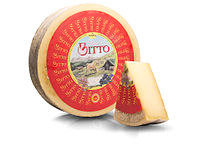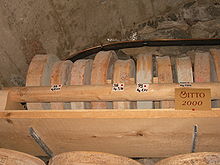Bitto
The bitto is a semi- hard or hard cheese made from raw milk , which is made from pure cow's milk or from cow's milk with an addition of up to ten percent goat's milk . Bitto is a protected designation of origin , the cheese may only be produced in Valtellina and the Brembo valley . A group of traditional cheese manufacturers did not accept the specifications for the production of the cheese and had been marketing the Bitto storico since 2006, the production of which was subject to significantly higher requirements and which was promoted by Slow Food . Since Bitto is a protected designation of origin, this cheese has been marketed as Storico ribelle since 2016 .
properties
The cheese wheels of the Bitto are cylindrical with a diameter of 30 to 50 centimeters and a height of 8 to 12 centimeters. They have a characteristic concave edge. The weight of a loaf is between 8 and 25 kilograms. The dough has a fine-grain texture, sometimes with very few small holes. Depending on the degree of ripeness, its color ranges from white to ivory to straw yellow. The smooth cheese rind is 2 to 4 millimeters thick, and its color changes from straw yellow to brownish yellow as it ripens. The dough of the young Bitto has a mild, sweet taste, which in the case of mature cheeses and cheeses with a proportion of goat's milk initially has a slight note of nuts and caramel and becomes increasingly stronger and spicier.
After 70 days of ripening, the bitto has a moisture content of around 38 percent. Its protein content is 27 ± 3 percent and its fat content 34 ± 3 percent, each based on the cheese mass. A fat content of at least 45 percent fat in the dry matter is prescribed for ripe Bitto . Since no starter culture with lactic acid bacteria is added during production , the microflora of the young cheese can cause thermophilic streptococci , mesophilic Lactobacillus delbrueckii subsp. bulgaricus and Lactobacillus fermentum , Enterococcus faecium and other enterococci and yeasts . The lack of a starter culture also results in a comparatively high pH of around 6.0.
history
The name of the Bitto is derived from the mountain stream of the same name, a tributary of the Adda . On the alpine pastures in the valley of the Bitto, the cheese was traditionally made in the shepherds' stone huts called Calèec , which only had a linen tarpaulin as a roof during use. The original production area is limited to the municipalities of Gerola Alta and Albaredo per San Marco . The cheeses were first matured in cellars on the alpine pastures. At the end of summer they were brought to the valley, where they often continued to mature for several years. In the past, the production of such long-lasting cheeses was the only way for farmers to preserve the high nutrient content of summer milk for winter.
Bitto has been a protected designation of origin in the European Union since 1996 . The cheese is allowed in the whole province of Sondrio , on the mountain pastures of the municipalities of Averara , Carona , Cusio , Foppolo , Mezzoldo , Piazzatorre , Santa Brigida and Valleve in the province of Bergamo , as well as on the mountain pastures of Varrone, Artino and Lareggio of the municipalities of Introbio and Premana in the province of Lecco .
The recognition of the protected designation of origin was connected with the standardization of the production, which includes some relief compared to the traditional methods. The milk may only come from cows of regional breeds that graze on the alpine pastures and are only fed to a small extent. Bitto may only be produced from raw milk between June 1st and September 30th . Either pure cow's milk or cow's milk with an addition of up to ten percent goat's milk can be processed. Not only the keeping of the cows, but also every production step of the cheese, including the maturation, may only take place in the specified production area. The protected designation Bitto can be supplemented with the name of an alpine pasture if the milk comes exclusively from cows from this alpine pasture, and if the weather is very bad, additional feeding takes place. Cheese production must then start no later than half an hour after milking, and the addition of ferments is not allowed.
The publication of the production regulations and the production area for the Bitto resulted in several producers in the center of the production area leaving the consortium for the protection of Valtellina Casera and Bitto. They did not agree with the specifications for the production or with the delimitation of the production area and founded their own cooperative for the production and marketing of the bitto storico ( historical bitto ). The group criticized the allowance for additional feeding, the possibility of adding ferments to milk, the delimitation of the area of origin and the possibility of making bitto without adding goat's milk. Overall, they see the Bitto DOP as a pure marketing measure and as a fraud against the consumer, with which traditional cheese production is only pretended and actually replaced by industrial methods.
With the support of Slow Food , the Bitto rebels were able to establish a high quality product on the market that some connoisseurs consider more authentic than the Bitto DOP . Since they are not allowed to market it as Bitto and want to emphasize the independence of their product, they initially named their cheese Bitto storico . The Bitto storico is offered for about twice the price of the Bitto DOP . The manufacturers claim to contribute to the preservation of the endangered mountain goat breed Orobica with their traditional production . Under threat of legal action by the representatives of the consortium for the protection of Valtellina Casera and Bitto, the dissidents decided to rename their cheese, which has been marketed as Storico ribelle since September 1, 2016 .
Manufacturing
After milking, the uncooled whole milk is heated in a copper kettle that is heated over an open wood fire. A bacterial starter culture is not added, but commercial ferments can be added. Rennet is added at a temperature of 35 to 39 ° C. After about 30 minutes the milk will curdle. Within a further 30 minutes, the thickened meat is cut into a fraction with pieces the size of rice grains. The mass is heated to 48 to 52 ° C. and kept at this temperature for 15 to 30 minutes with stirring.
The curd is then filled into wooden molds and pressed for 10 to 24 hours. The cheeses are then removed from the molds and allowed to drain for a further 24 to 48 hours. Over the next 8 to 25 days, depending on the size of the cheese, the surface is repeatedly dry-salted. The maturation takes at least 70 days, but the Bitto can also be matured over several years. The bark is repeatedly turned, cleaned and scraped off. Traditionally, maturation can take more than ten years. From the age of one year, the bitto is considered a hard cheese and can be grated.
Use in the kitchen
The bitto is an ingredient in several regional dishes. These include pizzoccheri , buckwheat noodles from Valtellina, which are served with vegetables, potatoes and local cheeses such as Bitto or Valtellina Casera . Sciatt , Lombard for toad , are buckwheat donuts filled with cheese and fried in fat.
- Dishes with Bitto or Valtellina Casera
Pizzoccheri , here with you
Web links
- Consorzio per la Tutela dei formaggi Valtellina Casera e Bitto , Consortium for the Protection of Valtellina Casera and Bitto (Italian)
- Formaggio Bitto , website of Ribelli del Bitto, with Slow Food (Italian, English)
- Don't Show Me How it's Done, Tell Me its Story , YouTube, Video der Ribelli del Bitto and Slow Food (Italian with English subtitles, 10:08 min)
- Valtellina: The Bitto Museum on YouTube (Italian with English subtitles, 7:17 min)
- Valtellina: Bitto's Story on YouTube (Italian with English subtitles, 6:27 min)
literature
- Michele Corti: I ribelli del bitto. Quando una tradizione casearia diventa eversiva . Slow Food, Bra 2011, ISBN 978-88-8499-264-2 (191 pages).
supporting documents
- ↑ a b c d e Marco Gobbetti, Erasmo Neviani, Patrick Fox: The Cheeses of Italy: Science and Technology . With Contribution by Gian Maria Varanini. Springer International, Cham 2018, ISBN 978-3-319-89853-7 , chap. 6 , p. 98-274 , especially pp. 126-131 , doi : 10.1007 / 978-3-319-89854-4_6 .
- ↑ a b c Juliet Harbutt (Ed.): World Cheese Book . Dorling Kindersley, London a. a. 2009, ISBN 978-0-7566-5442-9 , pp. 105 .
- ↑ a b c d e f Publication of an amendment request according to Article 6 Paragraph 2 of Regulation (EC) No. 510/2006 of the Council for the protection of geographical indications and designations of origin for agricultural products and food (PDF; 731 kB), accessed on 2. February 2020
- ↑ Stefano Morandi, Milena Brasca, Roberta Lodi: Technological, phenotypic and genotypic characterization of wild lactic acid bacteria involved in the production of Bitto PDO Italian cheese . In: Dairy Science & Technology . tape 91 , no. 3 , 2011, ISBN 978-0-19-933088-1 , pp. 341-359 .
- ↑ Regulation (EC) No. 1263/96 of the Commission of July 1, 1996 supplementing the annex to Regulation (EC) No. 1107/96 on the registration of geographical indications and designations of origin in accordance with Article 17 of Regulation (EEC) No. . 2081/92 , accessed on February 2, 2020
- ↑ Cristina Grasseni: Bitto . In: Catherine Donnelly (Ed.): The Oxford Companion to Cheese . Oxford University Press, Oxford 2016, pp. 70-71 , doi : 10.1007 / s13594-011-0016-7 .
- ↑ Marissa Sertich Velie: naming cheese . In: Catherine Donnelly (Ed.): The Oxford Companion to Cheese . Oxford University Press, Oxford 2016, ISBN 978-0-19-933088-1 , pp. 507-509 .
- ↑ Bitto Storico. Retrieved February 2, 2020 .
- ↑ Michele Corti: Valtellina che gusto ... industriale. 2016, accessed February 2, 2020 .
- ↑ Marisa Fumagalli: La guerra del Bitto: il formaggio storico cambierà nome . In: Corriere della Sera . July 5, 2016 ( corriere.it [accessed February 2, 2020]).




